Inorganic Thin-Film Solar Cells: Challenges at the Terawatt-Scale
Abstract
:1. Introduction
2. The Rise of Inorganic Thin-Film Solar Cells
3. The Challenges
3.1. Availability of Safe Raw Materials
Possible Solutions
3.2. Power Conversion Efficiency (PCE)
3.2.1. Emerging Technologies
3.2.2. The Role of Grain Boundaries’ Passivation
3.3. Long Lifetime and Stable Operation
4. Conclusions
Funding
Data Availability Statement
Conflicts of Interest
References
- Our Common Future: Report of the World Commission on Environment and Development. UN Documents. Available online: http://www.un-documents.net/ocf-02.htm> (accessed on 31 July 2023).
- Available online: https://ukcop26.org/ (accessed on 31 July 2023).
- Hoffert, M.I.; Caldeira, K.; Jain, A.K.; Haites, E.F.; Harvey, L.D.D.; Potter, S.D.; Schlesinger, M.E.; Schneider, S.H.; Watts, R.G.; Wigley, T.M.L.; et al. Energy implications of future stabilization of atmospheric CO2 content. Nature 1998, 395, 881–884. [Google Scholar] [CrossRef]
- Photovoltaics Report Prepared by Fraunhofer Institute for Solar Energy Systems, ISE with Support of PSE Projects GmbH, Freiburg, 24 February 2022. Available online: www.ise.fraunhofer.de (accessed on 31 July 2022).
- Green, M.A.; Dunlop, E.D.; Hohl-Ebinger, J.; Yoshita, M.; Kopidakis, N.; Bothe, K.; Hinken, D.; Rauer, M.; Hao, X. Solar cell efficiency tables (Version 60). Prog. Photovolt. Res. Appl. 2022, 30, 687–701. [Google Scholar] [CrossRef]
- Ramanujam, J.; Singh, U.P. Copper indium gallium selenide based solar cells–a review. Energy Environ. Sci. 2017, 10, 1306–1319. [Google Scholar] [CrossRef]
- Romeo, A.; Artegiani, E. CdTe-Based Thin Film Solar Cells: Past, Present and Future. Energies 2021, 14, 1684. [Google Scholar] [CrossRef]
- European Commission, Study on the EU’s List of Critical Raw Materials—Final Report (2020). Available online: https://op.europa.eu/en/publication-detail/-/publication/c0d5292a-ee54-11ea-991b-01aa75ed71a1/language-en (accessed on 31 July 2023).
- Zheng, X.; Hou, Y.; Bao, C.; Yin, J.; Yuan, F.; Huang, Z.; Song, K.; Liu, J.; Troughton, J.; Gasparini, N.; et al. Managing grains and interfaces via ligand anchoring enables 22.3%-efficiency inverted perovskite solar cells. Nat. Energy 2020, 5, 131–140. [Google Scholar] [CrossRef]
- Larramona, G.; Choné, C.; Meissner, D.; Ernits, K.; Bras, P.; Ren, Y.; Martın-Salinas, R.; Rodrıguez-Villatoro, J.L.; Vermang, B.; Brammertz, G. Stability, reliability, upscaling and possible technological applications of kesterite solar cells. J. Phys. Energy 2020, 2, 024009. [Google Scholar] [CrossRef]
- IRENA. Future of Solar Photovoltaic: Deployment, Investment, Technology, Grid Integration and Socio-Economic Aspects (A Global Energy Transformation: Paper); International Renewable Energy Agency: Abu Dhabi, United Arab Emirates, 2019; Available online: https://www.energiaincitta.it/wp-content/uploads/2020/06/IRENA_Future_of_Solar_PV_2019.pdf (accessed on 31 July 2023).
- Novas, N.; Garcia, R.M.; Camacho, J.M.; Alcayde, A. Advances in Solar Energy towards Efficient and Sustainable Energy. Sustainability 2021, 13, 6295. [Google Scholar] [CrossRef]
- Peng, J.; Lu, L.; Yang, H. Review on Life Cycle Assessment of Energy Payback and Greenhouse Gas Emission of Solar Photovoltaic Systems. Renew. Sustain. Energy Rev. 2013, 19, 255–274. [Google Scholar] [CrossRef]
- Páez-Montoro, A.; García-Valderas, M.; Olías-Ruíz, E.; López-Ongil, C. Solar Energy Harvesting to Improve Capabilities of Wearable Devices. Sensors 2022, 22, 3950. [Google Scholar] [CrossRef]
- Anderson, B.A.; Azar, C.; Holmberg, J.; Karlsson, S. Material constraints for thin-film solar cells. Energy 1998, 23, 407–411. [Google Scholar] [CrossRef]
- Andersson, B.A. Materials availability for large-scale thin-film photovoltaics. Prog. Photovolt. Res. Appl. 2000, 8, 61–76. [Google Scholar] [CrossRef]
- USGS. Commodity Statistics and Information. U.S. Geological Survey National Minerals Information Center. Available online: https://minerals.usgs.gov/minerals/pubs/commodity/ (accessed on 31 July 2023).
- Cherradi, N. Solar PV Technologies What’s Next? Becquerel Institute: Brussels, Belgium, 2019. Available online: https://www.f10.org/pdf/Solar-PV-technologies-whats-next-Nabih-Cherradi.pdf (accessed on 31 July 2023).
- Rhodes, C.J. Endangered elements,critical raw materials and conflict minerals. Sci. Prog. 2019, 102, 304–350. [Google Scholar] [CrossRef]
- Hunt, A.J.; Farmer, T.J.; Clark, J.H. Elemental Sustainability and the Importance of Scarce Element Recovery (Chapter 1); Hunt, A.J., Ed.; Element recovery and sustainability; Royal Society of Chemistry: Cambridge, UK, 2013; pp. 1–28. [Google Scholar]
- Available online: https://www.rohsguide.com/ (accessed on 31 July 2023).
- Buitrago, E.; Novello, A.M.; Meyer, T. Third-Generation Solar Cells: Toxicity and Risk of Exposure. Helv. Chim. Acta 2020, 103, e2000074. [Google Scholar] [CrossRef]
- Vaessen, H.A.M.G.; Szteke, B. Beryllium in food and drinking water—A summary of available knowledge. Food Addit. Contam. 2000, 17, 149–159. [Google Scholar] [CrossRef] [PubMed]
- Available online: https://www.euchems.eu/wp-content/uploads/2018/10/Periodic-Table-ultimate-PDF.pdf (accessed on 31 July 2023).
- Wallace, S.K.; Mitzi, D.B.; Walsh, A. Te steady rise of kesterite solar cells. ACS Energy Lett. 2017, 2, 776–779. [Google Scholar] [CrossRef]
- Katagiri, H.; Sasaguchi, N.; Hando, S.; Hoshino, S.; Ohashi, J.; Yokota, T. Preparation and evaluation of Cu2ZnSnS4 thin flms by sulfurization of E–B evaporated precursors. Sol. Energy Mater. Sol. Cells 1997, 49, 407–414. [Google Scholar] [CrossRef]
- Pakštas, V.; Grincienė, G.; Selskis, A.; Balakauskas, B.; Talaikis, B.; Bruc, L.; Curmei, N.; Niaura, G.; Franckevičius, M. Improvement of CZTSSe flm quality and supestrate solar cell performance through optimized post-deposition annealing. Sci. Rep. 2022, 12, 16170. [Google Scholar] [CrossRef]
- Liu, X.; Feng, Y.; Cui, H.; Liu, F.; Hao, X.; Conibeer, G.; Mitzi, D.B.; Green, M. Te current status and future prospects of kesterite solar cells: A brief review. Prog. Photovolt. Res. Appl. 2016, 24, 879–898. [Google Scholar] [CrossRef]
- Akcaya, N.; Gremenok, V.; Zaretskaya, E.; Ozcelika, S. Investigation on the Properties of Cu2ZnSnSe4 and Cu2ZnSn(S,Se)4 Absorber Films Prepared by Magnetron Sputtering Technique Using Zn and ZnS Targets in Precursor Stacks. Int. J. Energy Res. 2021, 45, 2398–2415. [Google Scholar] [CrossRef]
- Akcaya, N.; Gremenok, V.; Ivanov, V.A.; Zaretskaya, E.; Ozcelik, S. Characterization of Cu2ZnSnS4 thin films prepared with and without thin Al2O3 barrier layer. Solar Energy 2022, 234, 137–151. [Google Scholar] [CrossRef]
- Kim, S.; Rana, T.R.; Kim, J.; Yang, K.-J.; Kang, J.-K.; Kim, D.H. Limiting efects of conduction band ofset and defect states on high efciency CZTSSe solar cell. Nano Energy 2018, 45, 75–83. [Google Scholar] [CrossRef]
- Katagiri, H.; Jimbo, K.; Maw, W.S.; Oishi, K.; Yamazaki, M.; Araki, H.; Takeuchi, A. Development of CZTS-based thin film solar cells. Thin Solid Films 2009, 517, 2455–2460. [Google Scholar] [CrossRef]
- Walsh, A.; Chen, S.; Wei, S.; Gong, X. Kesterite thin-flm solar cells: Advances in materials modelling of Cu2ZnSnS4. Adv. Energy Mater. 2012, 2, 400–409. [Google Scholar] [CrossRef]
- Yang, K.J.; Son, D.H.; Sung, S.J.; Sim, J.H.; Kim, Y.I.; Park, S.N.; Jeon, D.H.; Kim, J.; Hwang, D.K.; Jeon, C.W. A band-gap-graded CZTSSe solar cell with 12.3% efficiency. J. Mater. Chem. A 2016, 4, 10151–10158. [Google Scholar] [CrossRef]
- Minbashi, M.; Omrani, M.K.; Memarian, N.; Kim, D.-H. Comparison of theoretical and experimental results for band-gapgraded CZTSSe solar cell. Curr. Appl. Phys. 2017, 17, 1238–1243. [Google Scholar] [CrossRef]
- Wang, W.; Winkler, M.T.; Gunawan, O.; Gokmen, T.; Todorov, T.K.; Zhu, Y.; Mitzi, D. Device Characteristics of CZTSSe Thin-Film Solar Cells with 12.6% Efficiency. Adv. Energy Mater. 2014, 4, 1301465. [Google Scholar] [CrossRef]
- Best Research-Cell Efficiency Chart/Photovoltaic Research/NREL. Available online: https://www.nrel.gov/pv/cell-efficiency.html (accessed on 31 July 2023).
- Yang, N.; Sun, H. Bismuth: Environmental Pollution and Health Effects. In Encyclopedia of Environmental Health; Nriagu, J.O., Ed.; Elsevier: Burlington, NJ, USA, 2011; pp. 414–420. [Google Scholar]
- Khan, M.D.; Aamir, M.; Sohail, M.; Bhoyate, S.; Hyatt, M.; Gupta, R.K.; Sher, M.; Revaprasadu, N. Electrochemical investigation of uncapped AgBiS2 (schapbachite) synthesized using in situ melts of xanthate precursors. Dalton Trans. 2019, 48, 3714–3722. [Google Scholar] [CrossRef]
- Wang, Y.; Kavanagh, S.R.; Burgués-Ceballos, I.; Walsh, A.; Scanlon, D.O.; Konstantatos, G. Cation disorder engineering yields AgBiS2 nanocrystals with enhanced optical absorption for efficient ultrathin solar cells. Nat. Photonics 2022, 16, 235–241. [Google Scholar] [CrossRef]
- Tang, R.; Wang, X.; Lian, W.; Huang, J.; Wei, Q.; Huang, M.; Yin, Y.; Jiang, C.; Yang, S.; Xing, G.; et al. Hydrothermal Deposition of Antimony Selenosulfide Thin Films Enables Solar Cells with 10% Efficiency. Nat. Energy 2020, 5, 587–595. [Google Scholar] [CrossRef]
- Available online: https://www.oecd.org/environment/waste/OECD-G20-Towards-a-more-Resource-Efficient-and-Circular-Economy.pdf (accessed on 31 July 2023).
- Johnson, D.B. Biomining—Biotechnologies for extracting and recovering metals from ores and waste materials. Curr. Opin. Biotechnol. 2014, 30, 24–31. [Google Scholar] [CrossRef]
- Rawlings, D.E. Heavy metal mining using microbes. Annu. Rev. Microbiol. 2002, 56, 65–91. [Google Scholar] [CrossRef]
- Johnson, D.B. The Biogeochemistry of Biomining. In Geomicrobiology: Molecular and Environmental Perspective; Barton, L., Mandl, M., Loy, A., Eds.; Springer: Berlin/Heidelberg, Germany, 2010; pp. 401–426. [Google Scholar]
- Wang, D.; Qui, G.; Liu, X. The progress of biohydrometallurgy in China. In Biohydrometallurgy: Biotech Key to Unlock Mineral Resources Value; Qui, G., Jiang, T., Qin, W., Liu, X., Yang, Y., Wang, H., Eds.; Central South University Press: Changsha, China, 2011. [Google Scholar]
- Olson, G.J.; Brierley, J.A.; Brierley, C.L. Bioleaching review. Part B. Progress in bioleaching: Applications of microbial processes by the minerals industry. Appl. Microbiol. Biotechnol. 2003, 63, 249–257. [Google Scholar] [CrossRef] [PubMed]
- Ehrlich, H.R. Past, present and future of biohydrometallurgy. In Biohydrometallurgy and the Environment Toward the Mining of the 21st Century; Process Metallurgy 9A; Amils, R., Ballester, A., Eds.; Elsevier: Amsterdam, The Netherlands, 1999; pp. 3–9. [Google Scholar]
- Available online: https://www.angloamerican.com/sustainability/tailings-summary/managing-tailings-safely (accessed on 31 July 2023).
- Ehrler, B.; Alarcón-Lladó, E.; Tabernig, S.W.; Veeken, T.; Garnett, E.C.; Polman, A. Photovoltaics Reaching for the Shockley–Queisser Limit. ACS Energy Lett. 2020, 5, 3029–3033. [Google Scholar] [CrossRef]
- Würfel, P. Limitations on energy conversion in solar cells. In Physics of Solar Cells; Wiley-VCH Verlag GmbH: Weinheim, Germany, 2007; pp. 137–153. [Google Scholar]
- Di Vece, M. Using Nanoparticles as a Bottom-up Approach to Increase Solar Cell Efficiency. KONA Powder Part. J. 2019, 36, 72–87. [Google Scholar] [CrossRef]
- Tiedje, T. Band tail recombination limit to the output voltage of amorphous silicon solar cells. Appl. Phys. Lett. 1982, 40, 627–629. [Google Scholar] [CrossRef]
- Rau, U.; Werner, J.H. Radiative efficiency limits of solar cells with lateral band-gap fluctuations. Appl. Phys. Lett. 2004, 84, 3735–3737. [Google Scholar] [CrossRef]
- Rau, U.; Paetzold, U.W.; Kirchartz, T. Thermodynamics of light management in photovoltaic devices. Phys. Rev. B 2014, 90, 035211. [Google Scholar] [CrossRef]
- Kurtz, S.; Repins, I.; Metzger, W.K.; Verlinden, P.J.; Huang, S.; Bowden, S.; Tappan, I.; Emery, K.; Kazmerski, L.; Levi, D. Historical Analysis of Champion Photovoltaic Module Efficiencies. IEEE J. Photovolt. 2018, 8, 363–372. [Google Scholar] [CrossRef]
- Nakamura, M.; Yamaguchi, K.; Kimoto, Y.; Yasaki, Y.; Kato, T.; Sugimoto, H. Cd-Free Cu(In,Ga)(Se,S)2 Thin-Film Solar Cell With Record Efficiency of 23.35%. IEEE J. Photovolt. 2019, 9, 1863–1867. [Google Scholar] [CrossRef]
- Han, Y.; Ao, J.; Zhang, J.; Gao, Q.; Guo, J.; Liu, W.; Liu, F.; Zhang, Y. Investigation on the Structure and Morphology of CZTSe Solar Cells by Adjusting Cu–Ge Buffer Layers. ACS Appl. Energy Mater. 2021, 4, 11793–11801. [Google Scholar] [CrossRef]
- Yang, B.; Qin, S.; Xue, D.-J.; Chen, C.; He, D.; Niu, D.; Huang, H.; Tang, J. In situ sulfurization to generate Sb2(Se1-xSx)3 alloyed films and their application for photovoltaics. Prog. Photovolt Res. Appl. 2017, 25, 113–122. [Google Scholar] [CrossRef]
- Chirila, A.; Reinhard, P.; Pianezzi, F.; Bloesch, P.; Uhl, A.R.; Fella, C.; Kranz, L.; Keller, D.; Gretener, C.; Hagendorfer, C. Potassium-induced surface modification of Cu(In,Ga)Se2 thin films for high-efficiency solar cells. Nat. Mater. 2013, 12, 1107–1111. [Google Scholar] [CrossRef]
- O’Neill, A.; Jo, E.; Choi, E.; Park, D.J.; Kim, J.H.; Yun, J.S.; Seidel, J. Enhancing CZTSSe solar cells through electric field induced ion migration. J. Mater. Chem. A 2022, 10, 5642–5649. [Google Scholar] [CrossRef]
- Delgado-Sanchez, J.M.; Lillo-Bravo, I. High Vapor Transport Deposition: A Novel Process to Develop Cu2ZnSn(SxSe1–x)4 Thin Film Solar Cells. Sol. RRL 2022, 6, 2100835. [Google Scholar] [CrossRef]
- Giraldo, S.; Jehl, Z.; Placidi, M.; Izquierdo-Roca, V.; Pérez-Rodríguez, A.; Saucedo, E. Progress and Perspectives of Thin Film Kesterite Photovoltaic Technology: A Critical Review. Adv. Mater. 2019, 31, 1806692. [Google Scholar] [CrossRef] [PubMed]
- Available online: https://www.pveducation.org/pvcdrom/materials/cztsse (accessed on 31 July 2023).
- Scragg, J.J.; Watjen, J.T.; Edoff, M.; Ericson, T.; Kubart, T.; Platzer-Björkman, C. A Detrimental Reaction at the Molybdenum Back Contact in Cu2ZnSn(S,Se)4 Thin-Film Solar Cells. J. Am. Chem. Soc. 2012, 134, 19330–19333. [Google Scholar] [CrossRef]
- Scragg, J.J.; Kubart, T.; Wätjen, J.T.; Ericson, T.; Linnarsson, M.K.; Platzer-Björkman, C. Effects of Back Contact Instability on Cu2ZnSnS4 Devices and Processes. Chem. Mater. 2013, 25, 3162–3171. [Google Scholar] [CrossRef]
- Dalapati, G.K.; Zhuk, S.; Masudy-Panah, S.; Kushwaha, A.; Seng, H.L.; Chellappan, V.; Suresh, V.; Su, Z.; Batabyal, S.K.; Tan, C.C.; et al. Impact of molybdenum out diffusion and interface quality on the performance of sputter grown CZTS based solar cells. Sci. Rep. 2017, 7, 1350. [Google Scholar] [CrossRef]
- Kim, J.; Kim, G.Y.; Jo, W.; Yang, K.-J.; Sim, J.-H.; Kim, D.-H.; Kang, J.-K. Effects of Mo back-contact annealing on surface potential and carrier transport in Cu2ZnSnS4 thin film solar cells. RSC Adv. 2016, 6, 103337–103345. [Google Scholar] [CrossRef]
- Kohara, N.; Nishiwaki, S.; Hashimoto, Y.; Negami, T.; Wada, T. Electrical properties of the Cu(In,Ga)Se2/MoSe2/Mo structure. Sol. Energy Mater. Sol. Cells 2011, 67, 209–215. [Google Scholar] [CrossRef]
- Wada, T.; Kohara, N.; Nishiwaki, S.; Negami, T. Characterization of the Cu(In,Ga)Se2/Mo Interface in CIGS Solar Cells. Thin Solid Films 2001, 387, 118–122. [Google Scholar] [CrossRef]
- Assmann, L.; Bernede, J.; Drici, A.; Amory, C.; Halgand, E.; Morsli, M. Study of the Mo Thin Films and Mo/CIGS Interface Properties. Appl. Surf. Sci. 2005, 246, 159–166. [Google Scholar] [CrossRef]
- Orgassa, K.; Schock, H.W.; Werner, J. Alternative back contact materials for thin film Cu(In,Ga)Se2 solar cells. Thin Solid Film. 2003, 431, 387–391. [Google Scholar] [CrossRef]
- Kaur, K.; Kumar, N.; Kumar, M. Strategic review of interface carrier recombination in earth abundant Cu–Zn–Sn–S–Se solar cells: Current challenges and future prospects. J. Mater. Chem. A 2017, 5, 3069–3090. [Google Scholar] [CrossRef]
- Chen, C.-Y.; Kholimatussadiah, S.; Chen, W.-C.; Lin, Y.-R.; Lin, J.-W.; Chen, P.-T.; Chen, R.-S.; Chen, H.-K.; Chen, L.-C. Back Contact Engineering to Improve CZTSSe Solar Cell Performance by Inserting MoO3 Sacrificial Nanolayers. Sustainability 2022, 14, 9511. [Google Scholar] [CrossRef]
- Polizzotti, A.; Repins, I.L.; Noufi, R.; Wei, S.-H.; Mitzi, D.B. The state and future prospects of kesterite photovoltaics. Energy Environ. Sci. 2013, 6, 3171–3182. [Google Scholar] [CrossRef]
- Sun, K.; Yan, C.; Huang, J.; Liu, F.; Li, J.; Sun, H.; Zhang, Y.; Cui, X.; Wang, A.; Fang, Z.; et al. Beyond 10% efficiency Cu2ZnSnS4 solar cells enabled by modifying the heterojunction interface chemistry. J. Mater. Chem. A 2019, 7, 27289–27296. [Google Scholar] [CrossRef]
- Sun, Y.; Lin, S.; Li, W.; Cheng, S.; Zhang, Y.; Liu, Y.; Liu, W. Review on Alkali Element Doping in Cu(In,Ga)Se2 Thin Films and Solar Cells. Engineering 2017, 3, 452–459. [Google Scholar] [CrossRef]
- Jackson, P.; Wuerz, R.; Hariskos, D.; Lotter, E.; Witte, W.; Powalla, M. Effects of heavy alkali elements in Cu(In,Ga)Se2 solar cells with efficiencies up to 22.6%. Phys. Status Solidi RRL 2016, 10, 583–586. [Google Scholar] [CrossRef]
- Nisika; Kaur, K.; Kumar, M. Progress and prospects of CZTSSe/CdS interface engineering to combat high open-circuit voltage deficit of kesterite photovoltaics: A critical review. J. Mater. Chem. A 2020, 8, 21547–21584. [Google Scholar] [CrossRef]
- Pal, K.; Singh, P.; Bhaduri, A.; Thapa, K.B. Current challenges and future prospects for a highly efficient (>20%) kesterite CZTS solar cell: A review. Sol. Energy Mater. Sol. Cells 2019, 196, 138–156. [Google Scholar] [CrossRef]
- Song, X.; Ji, X.; Li, M.; Lin, W.; Luo, X.; Zhang, H. A Review on Development Prospect of CZTS Based Thin Film Solar Cells. Int. J. Photoenergy 2014, 2014, 613173. [Google Scholar] [CrossRef]
- Ravindiran, M.; Praveenkumar, C. Status review and the future prospects of CZTS based solar cell—A novel approach on the device structure and material modeling for CZTS based photovoltaic device. Renew. Sustain. Energy Rev. 2018, 94, 317–329. [Google Scholar] [CrossRef]
- Abermann, S. Non-vacuum processed next generation thin film photovoltaics: Towards marketable efficiency and production of CZTS based solar cells. Solar Energy 2013, 94, 37–70. [Google Scholar] [CrossRef]
- Bras, P.; Frisk, C.; Tempez, A.; Niemi, E.; Platzer-Björkman, C. Ga-grading and Solar Cell Capacitance Simulation of an industrial Cu(In,Ga)Se2 solar cell produced by an in-line vacuum, all-sputtering process. Thin Solid Film. 2017, 582, 367–374. [Google Scholar] [CrossRef]
- Bras, P.; Sterner, J.; Platzer-Björkman, C. Investigation of blister formation in sputtered Cu2ZnSnS4 absorbers for thin film solar cells. J. Vac. Sci. Technol. A 2015, 33, 061201. [Google Scholar] [CrossRef]
- George, S.M. Atomic Layer Deposition: An Overview. Chem. Rev. 2010, 110, 111–131. [Google Scholar] [CrossRef]
- Bakke, J.R.; Jung, H.J.; Tanskanen, J.T.; Sinclair, R.; Bent, S.F. Atomic layer deposition of CdS films. Chem. Mater. 2010, 22, 4669–4678. [Google Scholar] [CrossRef]
- Ablekim, T.; Duenow, J.N.; Zheng, X.; Moutinho, H.; Moseley, J.; Perkins, C.L.; Johnston, S.W.; O’Keefe, P.; Colegrove, E.; Albin, D.S.; et al. Thin-Film Solar Cells with 19% Efficiency by Thermal Evaporation of CdSe and CdTe. ACS Energy Lett. 2020, 5, 892–896. [Google Scholar] [CrossRef]
- Liu, X.; Chen, J.; Luo, M.; Leng, M.; Xia, Z.; Zhou, Y.; Qin, S.; Xue, D.-J.; Lv, L.; Huang, H.; et al. Thermal Evaporation and Characterization of Sb2Se3 Thin Film for Substrate Sb2Se3/CdS Solar Cells. ACS Appl. Mater. Interfaces 2014, 6, 10687–10695. [Google Scholar] [CrossRef]
- Djessas, K.; Masse, G.; Ibannaim, M. CuInS2 Thin Films for Solar Cell Applications. J. Electrochem. Soc. 2000, 147, 1235–1239. [Google Scholar] [CrossRef]
- Sagna, A.; Djessas, K.; Sene, C.; Belaqziz, M.; Chehouani, H.; Briot, O.; Moret, M. Growth, structure and optoelectronic characterizations of high quality Cu2ZnSnS4 thin films obtained by close spaced vapor transport. Superlattices Microstruct. 2015, 85, 918–924. [Google Scholar] [CrossRef]
- Hou, K.; Liu, G.; Yang, J.; Wang, W.; Xia, L.; Zhang, J.; Xu, B.; Yang, B. Vacuum Electrodeposition of Cu(In, Ga)Se2 Thin Films and Controlling the Ga Incorporation Route. Crystals 2023, 13, 319. [Google Scholar] [CrossRef]
- Wan, L.; Guo, X.; Fang, Y.; Mao, X.; Guo, H.; Xu, J.; Zhou, R. Spray pyrolysis deposited CuSbS2 absorber layers for thin-film solar cells. J. Mater. Sci. Mater. Electron. 2019, 30, 21485–21494. [Google Scholar] [CrossRef]
- Bartsch, J.; Heitmann, U.; Jakob, L.; Mahmoud Algazzar, R.; Tutsch, L.; Hermann, R.; Kluska, S.; Bivour, M.; Bläsi, H.; Janz, S.; et al. Spray pyrolysis: A versatile technique for thin film deposition in PV. In Proceedings of the 37th European Solar Energy Conference and Exhibition, Lisboa, Portugal, 7–11 September 2020. [Google Scholar]
- Alexander, J.N.; Higashiya, S.; Caskey, D.; Efstathiadis, H.; Haldar, P. Deposition and characterization of cadmium sulfide (CdS) by chemical bath deposition using an alternative chemistry cadmium precursor. Sol. Energy Mater. Sol. Cells 2014, 125, 47–53. [Google Scholar] [CrossRef]
- Lee, T.Y.; Lee, I.H.; Jung, S.H.; Chung, C.W. Characteristics of CdS thin films deposited on glass and Cu(In,Ga)Se2 layer using chemical bath deposition. Thin Solid Film. 2013, 548, 64–68. [Google Scholar] [CrossRef]
- Lee, S.; Lee, E.S.; Kim, T.Y.; Cho, J.S.; Eo, Y.J.; Yun, J.H.; Cho, A. Effect of annealing treatment on CdS/CIGS thin film solar cells depending on different CdS deposition temperatures. Sol. Energy Mater. Sol. Cells 2015, 141, 299–308. [Google Scholar] [CrossRef]
- Pettit, R.B.; Brinker, C.J. Use of sol-gel thin films in solar energy applications. Sol. Energy Mater. 1986, 14, 269–287. [Google Scholar] [CrossRef]
- Matur, U.C.; Baydogan, N. Sol–Gel Derived Cu(In,Ga)Se2 Thin Film Solar Cell. J. Nanoelectron. Optoelectron. 2017, 2, 352–358. [Google Scholar] [CrossRef]
- Shen, X.; Tang, C.; Zhang, C.; Li, G.; Zhao, Y.; Li, W.; Chen, G.; Yang, T. CuZnSn(SxSe1-x)4 Solar Cell Prepared by the Sol-Gel Method Following a Modified Three-Step Selenization Process. Crystals 2019, 9, 474. [Google Scholar] [CrossRef]
- Sánchez Pinzóna, D.L.; Gómez Cuaspud, J.A.; Vera López, E.; Schmal, M. Hydrothermal Synthesis and Evaluation of the Cu2ZnSnS4 for Photovoltaic Applications. Mater. Res. 2021, 24, e20200290. [Google Scholar] [CrossRef]
- Yang, R.; Mazalan, E.; Chaudhary, K.T.; Haider, Z.; Ali, J. Non-vacuum deposition methods for thin film solar cell: Review. AIP Conf. Proc. 2017, 1824, 030018. [Google Scholar]
- Hibberd, C.J.; Chassaing, E.; Liu, W.; Mitzi, D.B.; Lincot, D.; Tiwari, A.N. Non-vacuum methods for formation of Cu(In, Ga) (Se, S)2 thin film photovoltaic absorbers. Prog. Photovolt. 2010, 18, 434–452. [Google Scholar] [CrossRef]
- Estela Calixto, M.; Dobson, K.D.; McCandless, B.E.; Birkmire, R.W. Controlling Growth Chemistry and Morphology of Single-Bath Electrodeposited Cu(In, Ga)Se2 Thin Films for Photovoltaic Application. J. Electrochem. Soc. 2006, 153, G521–G528. [Google Scholar] [CrossRef]
- Kondrotas, R.; Chen, C.; Tang, J. Sb2S3 Solar Cells. Joule 2018, 2, 857–878. [Google Scholar] [CrossRef]
- Wijesinghe, U.; Longo, G.; Hutter, O.S. Defect engineering in antimony selenide thin film solar cells. Energy Adv. 2023, 2, 12–33. [Google Scholar] [CrossRef]
- Barthwal, S.; Kumar, R.; Pathak, S. Present Status and Future Perspective of Antimony Chalcogenide (Sb2X3) Photovoltaics. ACS Appl. Energy Mater. 2022, 5, 6545–6585. [Google Scholar] [CrossRef]
- Yang, B.; Xue, D.J.; Leng, M.; Zhong, J.; Wang, L.; Song, H.; Zhou, Y.; Tang, J. Hydrazine solution processed Sb2S3,Sb2Se3 and Sb2(S1−xSex)3 film: Molecular precursor identification, film fabrication and band gap tuning. Sci. Rep. 2015, 5, 10978. [Google Scholar] [CrossRef]
- El-Wahabb, E.A.; Fouad, S.S.; Fadel, M. Theoretical and experimental study of the conduction mechanism in Sb2Se3 alloy. J. Mater. Sci. 2003, 38, 527–532. [Google Scholar] [CrossRef]
- Shockley, W.; Queisser, H.J. Detailed balance limit of efficiency of p-n junction solar cells. J. Appl. Phys. 1961, 32, 510–519. [Google Scholar] [CrossRef]
- Basak, A.; Singh, U.P. Numerical modelling and analysis of earth abundant Sb2S3 and Sb2Se3 based solar cells using SCAPS-1D. Sol. Energy Mater. Sol. Cells 2021, 230, 111184. [Google Scholar] [CrossRef]
- Zhang, J.; Lian, W.; Yin, Y.; Wang, X.; Tang, R.; Qian, C.; Hao, X.; Xhu, C.; Chen, T. All antimony chalcogenide tandem solar cell. Sol RRL 2020, 4, 2000048. [Google Scholar] [CrossRef]
- Zhou, Y.; Wang, L.; Chen, S.; Qin, S.; Liu, X.; Chen, J.; Xue, D.-J.; Luo, M.; Cao, Y.; Cheng, Y.; et al. Thin-Film Sb2Se3 Photovoltaics with Oriented One-Dimensional Ribbons and Benign Grain Boundaries. Nat. Photonics 2015, 9, 409–415. [Google Scholar] [CrossRef]
- Tideswell, N.W.; Kruse, F.H.; McCullough, J.D. The Crystal Structure of Antimony Selenide, Sb2Se3. Acta Crystallogr. 1957, 10, 99–102. [Google Scholar] [CrossRef]
- Wang, Y.; Ji, S.; Shin, B. Interface engineering of antimony selenide solar cells: A review on the optimization of energy band alignments. J. Phys. Energy 2022, 4, 044002. [Google Scholar] [CrossRef]
- Lian, W.; Jiang, C.; Yin, Y.; Tang, R.; Li, G.; Zhang, L.; Che, B.; Chen, T. Revealing composition and structure dependent deep-level defect in antimony trisulfide photovoltaics. Nat. Commun. 2021, 12, 3260. [Google Scholar] [CrossRef] [PubMed]
- Saleem, M.F.; Zhang, H.; Deng, Y.; Wang, D. Resonant Raman scattering in nanocrystalline thin CdS film. J. Raman Spectrosc. 2017, 48, 224–229. [Google Scholar] [CrossRef]
- Choi, Y.C.; Lee, D.U.; Noh, J.H.; Kim, E.K.; Seok, S.I. Highly improved Sb2S3 sensitized-inorganic–organic heterojunction solar cells and quantification of traps by deep-level transient spectroscopy. Adv. Funct. Mater. 2014, 24, 3587–3592. [Google Scholar] [CrossRef]
- Huang, M.; Xu, P.; Han, D.; Tang, J.; Chen, S. Complicated and unconventional defect properties of the quasi-one-dimensional photovoltaic semiconductor Sb2Se3. ACS Appl. Mater. Interfaces 2019, 11, 15564–15572. [Google Scholar] [CrossRef]
- Kukimoto, H.; Henry, C.; Merritt, F. Photocapacitance studies of the oxygen donor in GaP. I. Optical cross sections, energy levels, and concentration. Phys. Rev. B 1973, 7, 2486–2499. [Google Scholar] [CrossRef]
- Lin, B.; Sun, Q.; Zhang, C.; Deng, H.; Li, Y.; Xie, W.; Li, Y.; Zheng, Q.; Wu, J.; Cheng, S. Efficient Cd-Free Flexible CZTSSe Solar Cells with Quality Interfaces by Using the Zn1–xSnxO Buffer Layer. ACS Appl. Energy Mater. 2023, 6, 1037–1045. [Google Scholar] [CrossRef]
- Zhu, J.; Yu, J.; Wang, Z.; Wang, X.; Ou, Y.; Cai, M.; Wu, Z.; Tang, R.; Xia, Y.; Wang, Y.; et al. High-Performance and Stable Sb2S3 Thin-Film Photodetectors for Potential Application in Visible Light Communication. ACS Appl. Mater. Interfaces 2023, 15, 23, 28175–28183. [Google Scholar] [CrossRef] [PubMed]
- Ray, C.; Karanjai, M.K.; DasGupta, D. Deposition and Characterization of ZnXCd1-XS Thin Films Prepared by the Dip Technique. Thin Solid Film. 1998, 322, 117–122. [Google Scholar] [CrossRef]
- Cha, D.; Kim, S.; Huang, N.K. Study on Electrical Properties of CdS Films Prepared by Chemical Pyrolysis Deposition. Mater. Sci. Eng. B 2004, 106, 63–68. [Google Scholar] [CrossRef]
- Zhao, Y.; Wang, S.; Jiang, C.; Li, C.; Xiao, P.; Tang, R.; Gong, J.; Chen, G.; Chen, T.; Li, J.; et al. Regulating Energy Band Alignment via Alkaline Metal Fluoride Assisted Solution Post-Treatment Enabling Sb2(S,Se)3 Solar Cells with 10.7% Efficiency. Adv. Energy Mater. 2022, 12, 2103015. [Google Scholar] [CrossRef]
- Wu, C.; Zhang, L.; Ding, H.; Ju, H.; Jin, X.; Wang, X.; Zhu, C.; Chen, T. Direct solution deposition of device quality Sb2S3-xSex films for high efficiency solar cells. Sol. Energy Mater. Sol. Cells 2018, 183, 52–58. [Google Scholar] [CrossRef]
- Nair, P.K.; Medina, E.A.Z.; Vázque-García, G.; Guerrero Martínez, L.; Nair, M.T.S. Functional prototype modules of antimony sulfide selenide thin film solar cells. Thin Solid Film. 2019, 669, 410–418. [Google Scholar] [CrossRef]
- Wu, C.; Jiang, C.; Wang, X.; Ding, H.; Ju, H.; Zhang, L.; Chen, T.; Zhu, C. Interfacial Engineering by Indium-Doped CdS for High Efficiency Solution Processed Sb2(S1–xSex)3 Solar Cells. ACS Appl. Mater. Interfaces 2019, 11, 3207–3213. [Google Scholar] [CrossRef]
- Wang, W.; Wang, X.; Chen, G.; Yao, L.; Huang, X.; Chen, T.; Zhu, C.; Chen, S.; Huang, Z.; Zhang, Y. Over 6% Certified Sb2(S,Se)3 Solar Cells Fabricated via In Situ Hydrothermal Growth and Postselenization. Adv. Electron. Mater. 2019, 5, 1800683. [Google Scholar] [CrossRef]
- Jiang, C.; Yao, J.; Huang, P.; Tang, R.; Wang, X.; Lei, X.; Zeng, H.; Chang, S.; Zhong, H.; Yao, H. Perovskite Quantum Dots Exhibiting Strong Hole Extraction Capability for Efficient Inorganic Thin Film Solar Cells. Cell Rep. Phys. Sci. 2020, 1, 100001. [Google Scholar] [CrossRef]
- Wang, X.; Tang, R.; Jiang, C.; Lian, W.; Ju, H.; Jiang, G.; Li, Z.; Zhu, C.; Chen, T. Manipulating the Electrical Properties of Sb2(S,Se)3 Film for High-Efficiency Solar Cell. Adv. Energy Mater. 2020, 10, 2002341. [Google Scholar] [CrossRef]
- Han, G.; Zhang, S.; Boix, P.B.; Wong, L.H.; Sun, L.; Lien, S.-H. Towards high efficiency thin film solar cells. Prog. Mater. Sci. 2017, 87, 246–291. [Google Scholar] [CrossRef]
- Ferekides, C.S.; Balasubramanian, U.; Mamazza, R.; Viswanathan, V.; Zhao, H.; Morel, D.L. CdTe Thin Film Solar Cells: Device and Technology Issues. Sol. Energy 2004, 77, 823–830. [Google Scholar] [CrossRef]
- McCandless, B.E.; Youm, I.; Birkmire, R.W. Optimization of Vapor Post-Deposition Processing for Evaporated CdS/CdTe Solar Cells. Prog. Photovoltaics 1999, 7, 21–30. [Google Scholar] [CrossRef]
- Nakayama, N.; Matsumoto, H.; Yamaguchi, K.; Ikagami, S.; Hioki, Y. Ceramic thin film CdTe solar cell. Jan. J. Appl. Phys. 1976, 15, 2281–2282. [Google Scholar] [CrossRef]
- Fritsche, J.; Gunst, S.; Golusda, E.; Lejard, M.C.; Thißen, A.; Mayer, T.; Klein, A.; Wendt, R.; Gegenwart, R.; Bonnet, D.; et al. Surface analysis of CdTe thin film solar cells. Thin Solid Films 2001, 387, 161–164. [Google Scholar] [CrossRef]
- Tuteja, M.; Mei, A.B.; Palekis, V.; Hall, A.; MacLaren, S.; Ferekides, C.S.; Rockett, A.A. CdCl2 Treatment-Induced Enhanced Conductivity in CdTe Solar Cells Observed Using Conductive Atomic Force Microscopy. J. Phys. Chem. Lett. 2016, 7, 4962–4967. [Google Scholar] [CrossRef]
- Nicoara, N.; Manaligod, R.; Jackson, P.; Hariskos, D.; Witte, W.; Sozzi, G.; Menozzi, R.; Sadewasser, S. Direct evidence for grain boundary passivation in Cu(In,Ga)Se2 solar cells through alkali-fluoride post-deposition treatments. Nat. Commun. 2019, 10, 3980. [Google Scholar] [CrossRef]
- Martin, N.M.; Törndahl, T.; Wallin, E.; Simonov, K.A.; Rensmo, H.; Platzer-Björkman, C. Surface/Interface Effects by Alkali Postdeposition Treatments of (Ag,Cu)(In,Ga)Se2 Thin Film Solar Cells. ACS Appl. Energy Mater. 2022, 5, 461–468. [Google Scholar] [CrossRef]
- Kato, T.; Wu, J.; Hirai, Y.; Sugimoto, H.; Bermudez, V. Record efficiency for thin-film polycrystalline solar cells up to 22.9% Achieved by IEEE. J. Photovolt. 2019, 9, 325–330. [Google Scholar] [CrossRef]
- Solar Frontier. Solar Frontier Achieves World Record Thin-Film Solar Cell Efficiency of 23.35%. Available online: http://www.solar-frontier.com/eng/news/2019/0117_press.html (accessed on 31 July 2023).
- Jordan, D.C.; Kurtz, S.R. Photovoltaic degradation rates—An analytical review. Prog. Photovolt. 2013, 21, 12–29. [Google Scholar] [CrossRef]
- IEC 61215-1-4:2021; Terrestrial Photovoltaic (PV) Modules—Design Qualification and Type Approval—Part 1–4: Special Requirements for Testing of Thin-Film Cu(In,GA)(S,Se)2 Based Photovoltaic (PV) Modules. International Electrotechnical Commission: Geneva, Switzerland. Available online: https://webstore.iec.ch/publication/68599 (accessed on 31 July 2023).
- IEC 61215-1-2:2021; Terrestrial Photovoltaic (PV) Modules—Design Qualification and Type Approval—Part 1–2: Special Requirements for Testing of Thin-Film Cadmium Telluride (CdTe) Based Photovoltaic (PV) Modules. International Electrotechnical Commission: Geneva, Switzerland. Available online: https://webstore.iec.ch/publication/61347 (accessed on 31 July 2023).
- IEC 61215-1-3:2021; Terrestrial Photovoltaic (PV) Modules—Design Qualification and Type Approval—Part 1–3: Special Requirements for Testing of Thin-Film Amorphous Silicon based Photovoltaic (PV) Modules. International Electrotechnical Commission: Geneva, Switzerland. Available online: https://webstore.iec.ch/publication/61348 (accessed on 31 July 2023).
- Solís-Alemána, E.M.; la Casa, J.; Romero-Fiances, I.; Silva, J.P.; Nofuentes, G. A study on the degradation rates and the linearity of the performance decline of various thin film PV technologies. Solar Energy 2019, 188, 813–824. [Google Scholar] [CrossRef]
- Jordan, D.C.; Kurtz, S.R.; Van Sant, K.; Newmiller, J. Compendium of photovoltaic degradation rates. Prog. Photovoltaics Res. Appl. 2016, 24, 978–989. [Google Scholar] [CrossRef]
- Tamizhmani, G. Climate dependent degradation rates based on nation-wide onsite I-V measurements. In Proceedings of the 2016 PV Module Reliability Workshop, Lakewood, CO, USA, 23 February 2016. [Google Scholar]
- Kuitche, J.; Pan, R.; Tamizhmani, G. Investigation of dominant failure modes for field-aged c-Si modules in desert climatic conditions. IEEE J. Photovolt. 2014, 4, 814–826. [Google Scholar] [CrossRef]
- Tamizhmani, G.; Tatapudi, S.; Dubey, R.; Chattopadhyay, S.; Solanki, C.; Vasi, J.; Bora, B.; Sastry, O.S.; Kottantharayil, A. Comparative study of performance of fielded PV modules in two countries. In Proceedings of the 26th International Photovoltaic Science and Engineering Conference, Singapore, 24–28 October 2016. [Google Scholar]
- Dubey, R.; Chattopadhyay, S.; Kuthanazhi, V.; Kottantharayil, A.; Solanki, C.S.; Arora, B.M.; Narasimhan, K.L.; Vasi, J.; Bora, B.; Singh, J.K.; et al. Comprehensive study of performance degradation of field-mounted photovoltaic modules in India. Energy Sci. Eng. 2017, 5, 51–64. [Google Scholar] [CrossRef]
- Jawaharlal Nehru National Solar Mission (Phase I, II and III). Available online: https://www.iea.org/policies/4916-jawaharlal-nehru-national-solar-mission-phase-i-ii-and-iii (accessed on 31 July 2023).
- Munshi, A.H.; Sasidharan, N.; Pinkayan, S.; Barth, K.L.; Sampatha, W.S.; Ongsakul, W. Thin-film CdTe photovoltaics—The technology for utility scale sustainable energy generation. Sol. Energy 2018, 173, 511–516. [Google Scholar] [CrossRef]
- Silvestre, S.; Kichou, S.; Guglielminotti, L.; Nofuentes, G.; Alonso-Abella, M. Degradation analysis of thin film photovoltaic modules under outdoor long term exposure in Spanish continental climate conditions. Sol. Energy 2016, 139, 599–607. [Google Scholar] [CrossRef]
- Ghosh, A.; Sundaram, S.; Mallick, T.K. Colour properties and glazing factors evaluation of multicrystalline based semi-transparent Photovoltaic-vacuum glazing for BIPV application. Renew. Energy 2019, 131, 730–736. [Google Scholar] [CrossRef]
- Alrashidi, H.; Issa, W.; Sellami, N.; Ghosh, A.; Mallick, T.K.; Sundaram, S. Performance assessment of cadmium telluride-based semi-transparent glazing for power saving in façade buildings. Energy Build. 2020, 215, 109585. [Google Scholar] [CrossRef]
- Karthick, A.; Kalidasa Murugavel, K.; Ghosh, A.; Sudhakar, K.; Ramanan, P. Investigation of a binary eutectic mixture of phase change material for building integrated photovoltaic (BIPV) system. Sol. Energy Mater. Sol. Cells 2020, 207, 110360. [Google Scholar] [CrossRef]
- Karthick, A.; Ramanan, P.; Ghosh, A.; Stalin, B.; Kumar, R.V.; Baranilingesan, I. Performance enhancement of copper indium diselenide photovoltaic module using inorganic phase change material. Asia-Pac. J. Chem. Eng. 2020, 15, e2480. [Google Scholar] [CrossRef]
- Alrashidi, H.; Ghosh, A.; Issa, W.; Sellami, N.; Mallick, T.K.; Sundaram, S. Thermal performance of semitransparent CdTe BIPV window at temperate climate. Sol. Energy 2020, 195, 536–543. [Google Scholar] [CrossRef]
- Smestad, G.P.; Germer, T.A.; Alrashidi, H.; Fernández, E.F.; Dey, S.; Brahma, H.; Sarmah, N.; Ghosh, A.; Sellami, N. Modelling photovoltaic soiling losses through optical characterization. Sci. Rep. 2020, 10, 58. [Google Scholar] [CrossRef]
- Conceição, R.; Silva, H.G.; Mirão, J.; Collares-Pereira, M. Organic soiling: The role of pollen in PV module performance degradation. Energies 2018, 11, 294. [Google Scholar] [CrossRef]
- Pavan, A.M.; Tessarolo, A.; Barbini, N.; Mellit, A.; Lughi, V. The effect of manufacturing mismatch on energy production for large-scale photovoltaic plants. Sol. Energy 2015, 117, 282–289. [Google Scholar] [CrossRef]
- Qasem, H.; Betts, T.R.; Mullejans, H.; AlBusairi, H.; Gottschalg, R. Dust-induced shading on photovoltaic modules. Prog. Photovolt. Res. Appl. 2014, 22, 218–226. [Google Scholar] [CrossRef]
- Urrejola, E.; Antonanzas, J.; Ayala, P.; Salgado, M.; Ramírez-Sagner, G.; Cortés, C.; Pino, A.; Escobar, R. Effect of soiling and sunlight exposure on the performance ratio of photovoltaic technologies in Santiago, Chile. Energy Convers. Manag. 2016, 114, 338–347. [Google Scholar] [CrossRef]
- Cordero, R.R.; Damiani, A.; Laroze, D.; MacDonell, S.; Jorquera, J.; Sepúlveda, E.; Feron, S.; Llanillo, P.; Labbe, F.J.; Carrasco, J.; et al. Effects of soiling on photovoltaic (PV) modules in the Atacama Desert. Sci. Rep. 2018, 8, 13943. [Google Scholar] [CrossRef]
- Hachicha, A.A.; Al-Sawafa, I.; Said, Z. Impact of dust on the performance of solar photovoltaic (PV) systems under United Arab Emirates weather conditions. Renew. Energy 2019, 141, 287–297. [Google Scholar] [CrossRef]
- Memiche, M.; Bouzian, C.; Benzahia, A.; Moussi, A. Efects of dust, soiling, aging, and weather conditions on photovoltaic system performances in a Saharan environment—Case study in Algeria. Glob. Energy Interconnect. 2020, 3, 60–67. [Google Scholar] [CrossRef]
- Gholami, A.; Khazaee, I.; Eslami, S.; Zandi, M.; Akrami, E. Experimental investigation of dust deposition efects on photo-voltaic output performance. Sol. Energy 2018, 159, 346–352. [Google Scholar] [CrossRef]
- Chen, J.; Pan, G.; Ouyang, J.; Ma, J.; Fu, L.; Zhang, L. Study on impacts of dust accumulation and rainfall on PV power reduction in East China. Energy 2020, 194, 116915. [Google Scholar] [CrossRef]
- Fraga, M.M.; Campos, B.L.D.O.; Almeida, T.B.D.; Fonseca, J.M.F.D.; Lins, V.D.F.C. Analysis of the soiling efect on the performance of photovoltaic modules on a soccer stadium in Minas Gerais. Brazil. Sol. Energy 2018, 163, 387–397. [Google Scholar] [CrossRef]
- Xiao, K.; Wu, X.; Song, X.; Yuan, J.; Bai, W.; Wu, C.; Huang, C. Study on performance degradation and damage modes of thin-flm photovoltaic cell subjected. Sci. Rep. 2021, 11, 782. [Google Scholar] [CrossRef]
- Ghosh, A. Soiling Losses: A Barrier for India’s Energy Security Dependency from Photovoltaic Power. Challenges 2020, 11, 9. [Google Scholar] [CrossRef]
- Haegel, N.M.; Margolis, R.; Buonassisi, T.; Feldman, D.; Froitzheim, A.; Garabedian, R.; Green, M.; Glunz, S.; Henning, H.M.; Holder, B.; et al. Terawatt-scale photovoltaics: Trajectories and challenges. Science 2017, 356, 141–143. [Google Scholar] [CrossRef]
- Leading Solar PV Manufacturers Based on Module Shipments in 2018 and 2019. Available online: https://www.statista.com/statistics/858456/global-companies-for-pv-cell-and-module-shipments/ (accessed on 31 July 2023).
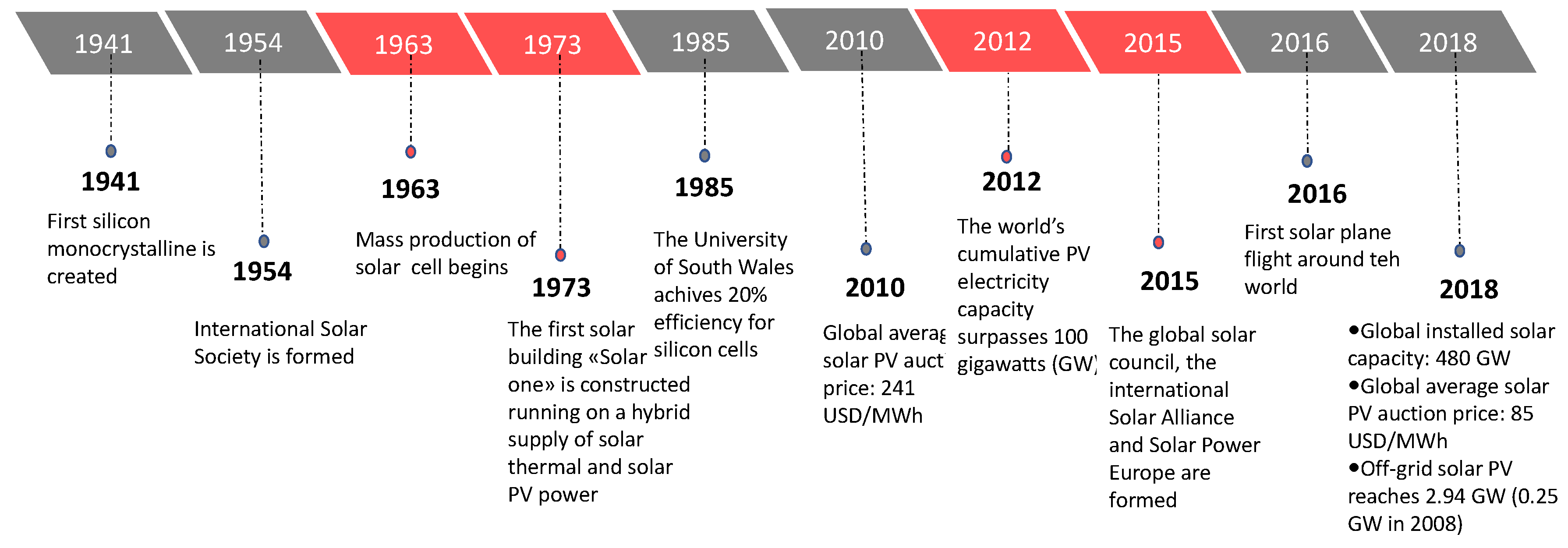
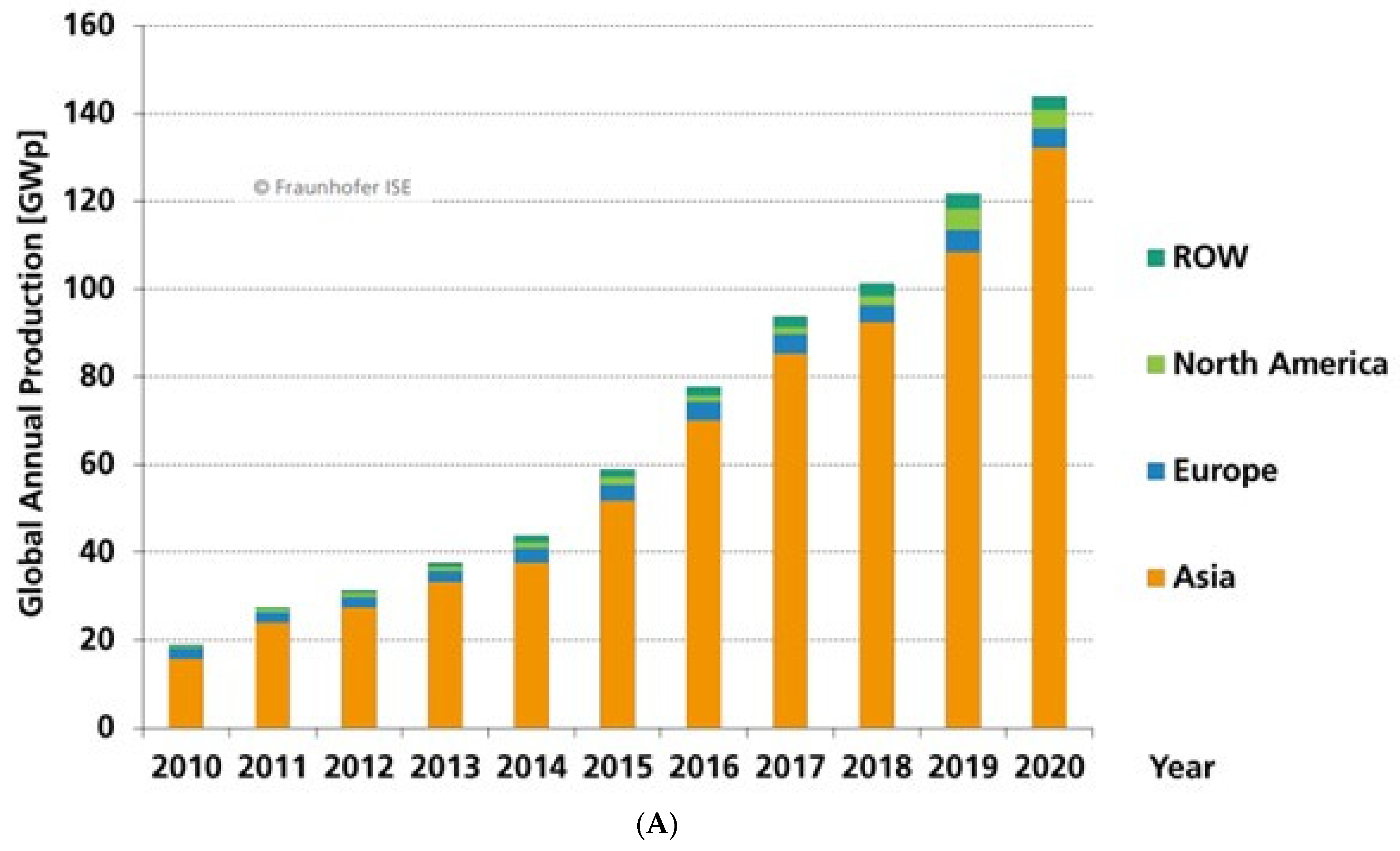
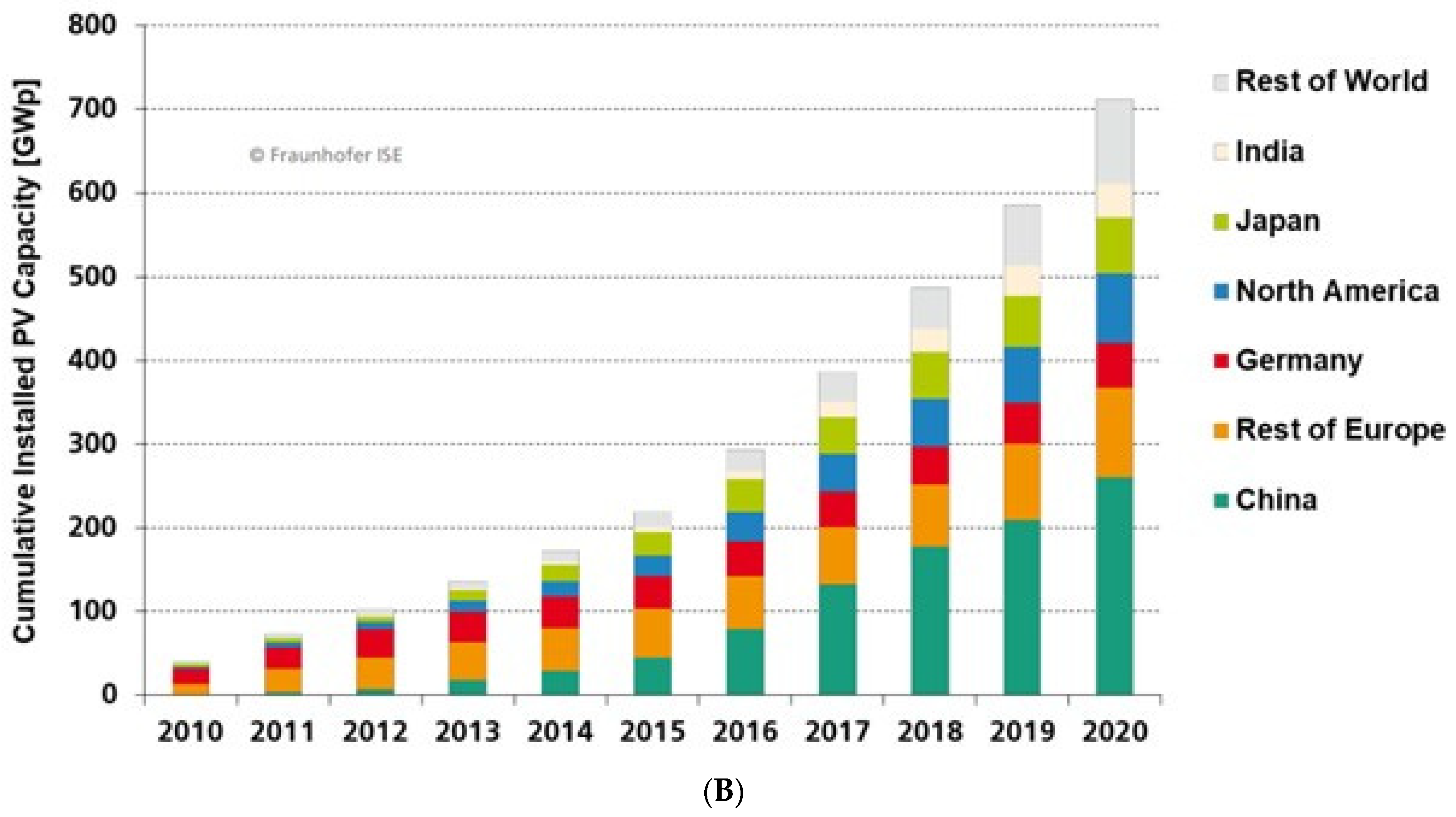


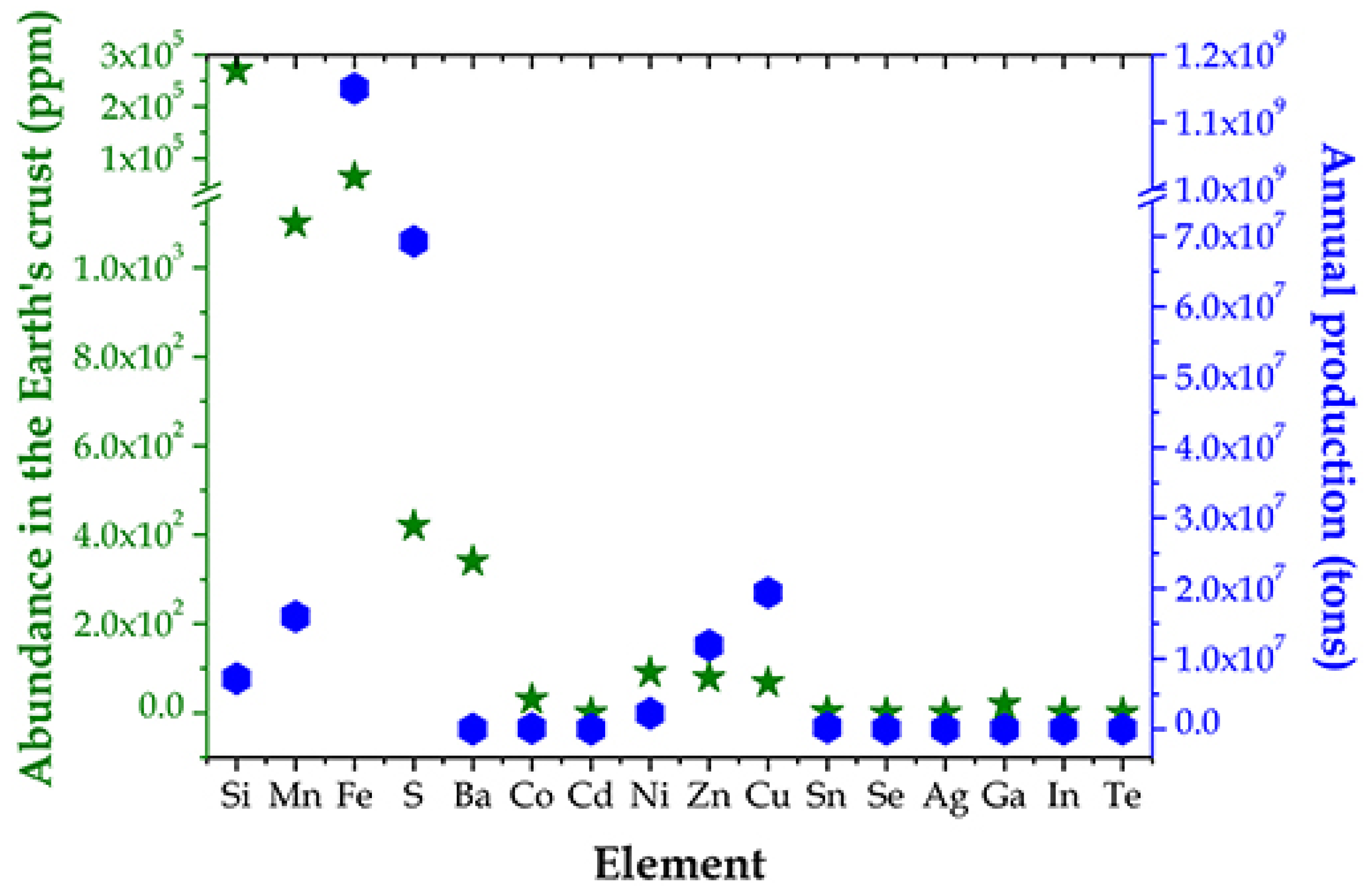


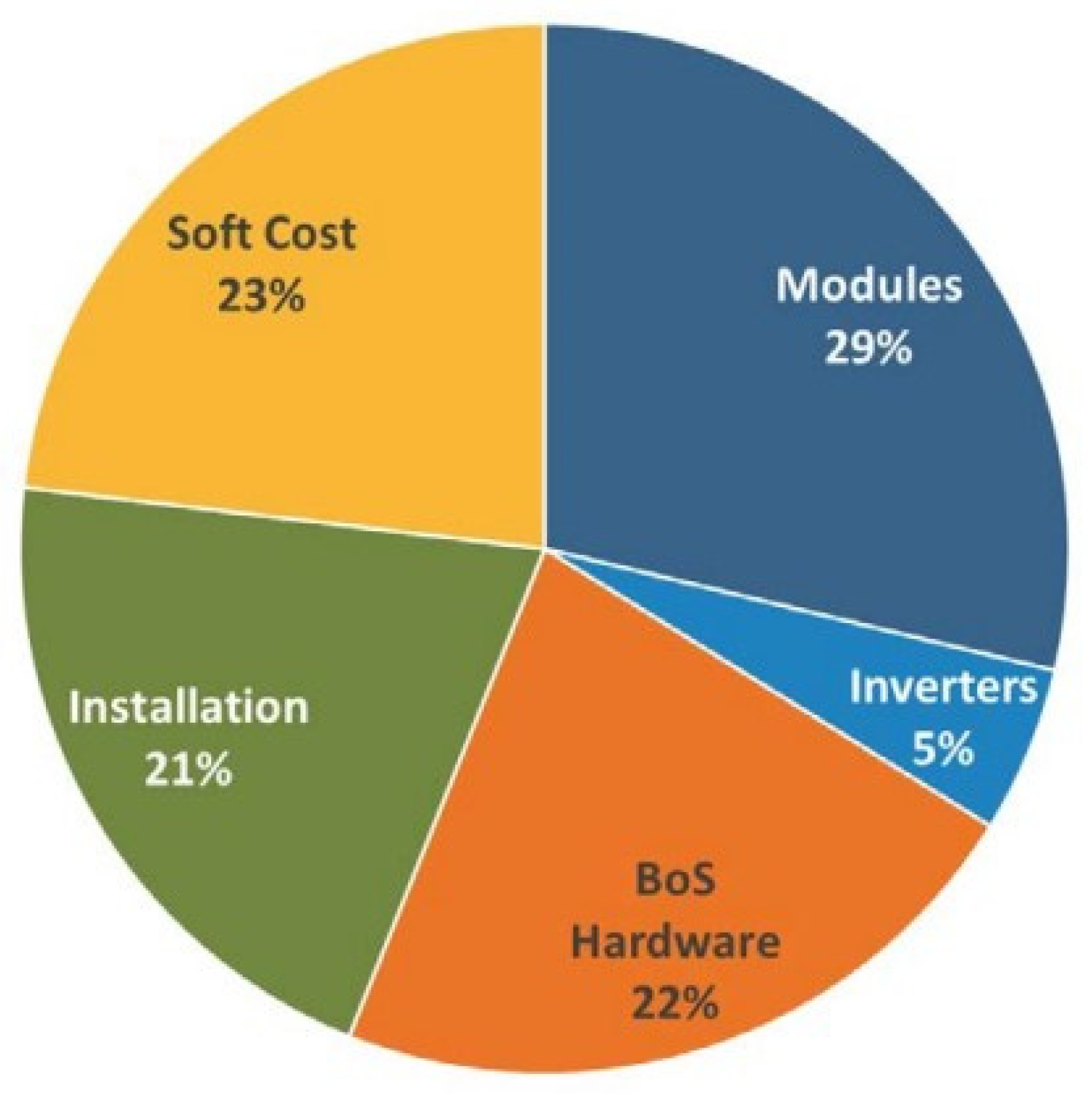
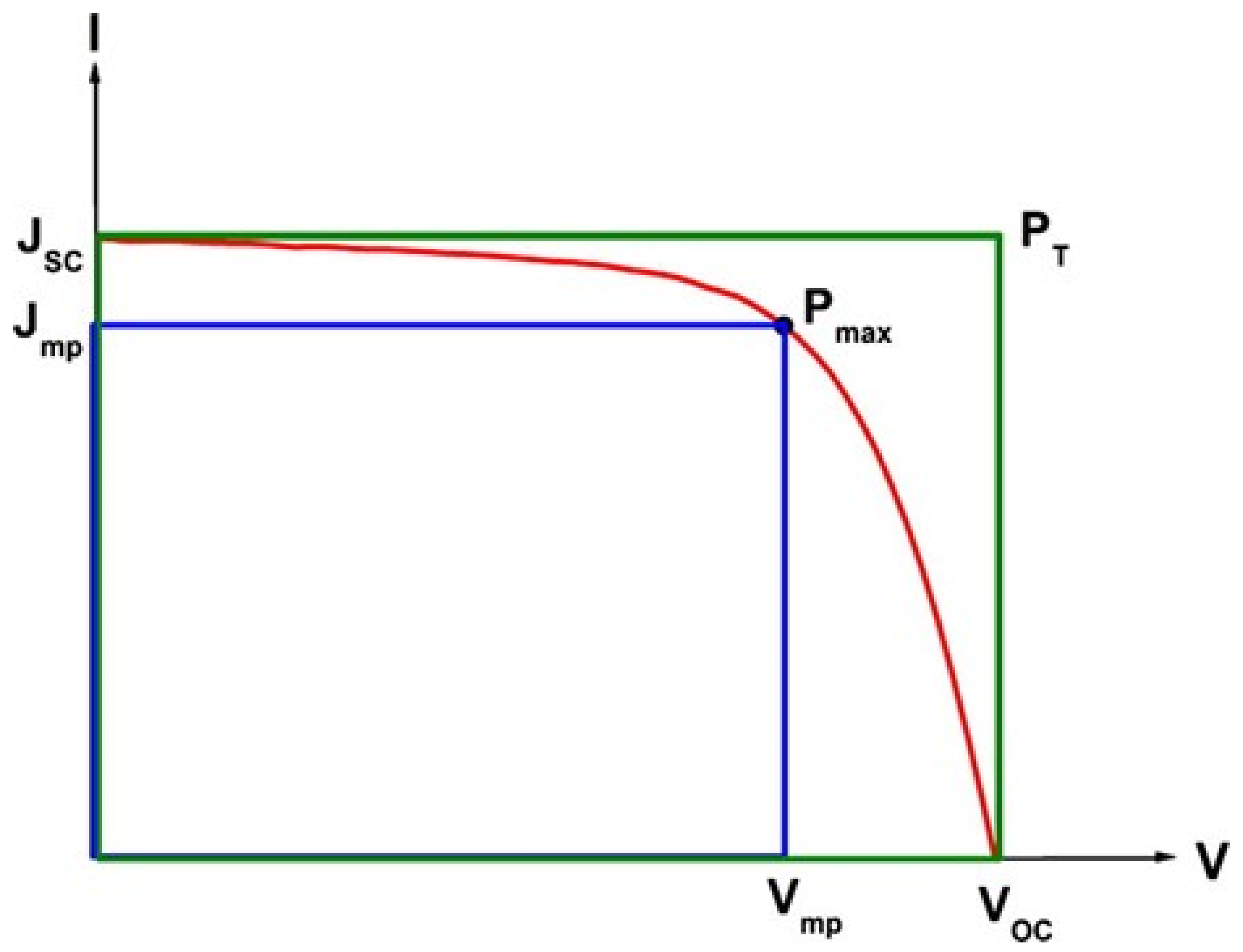



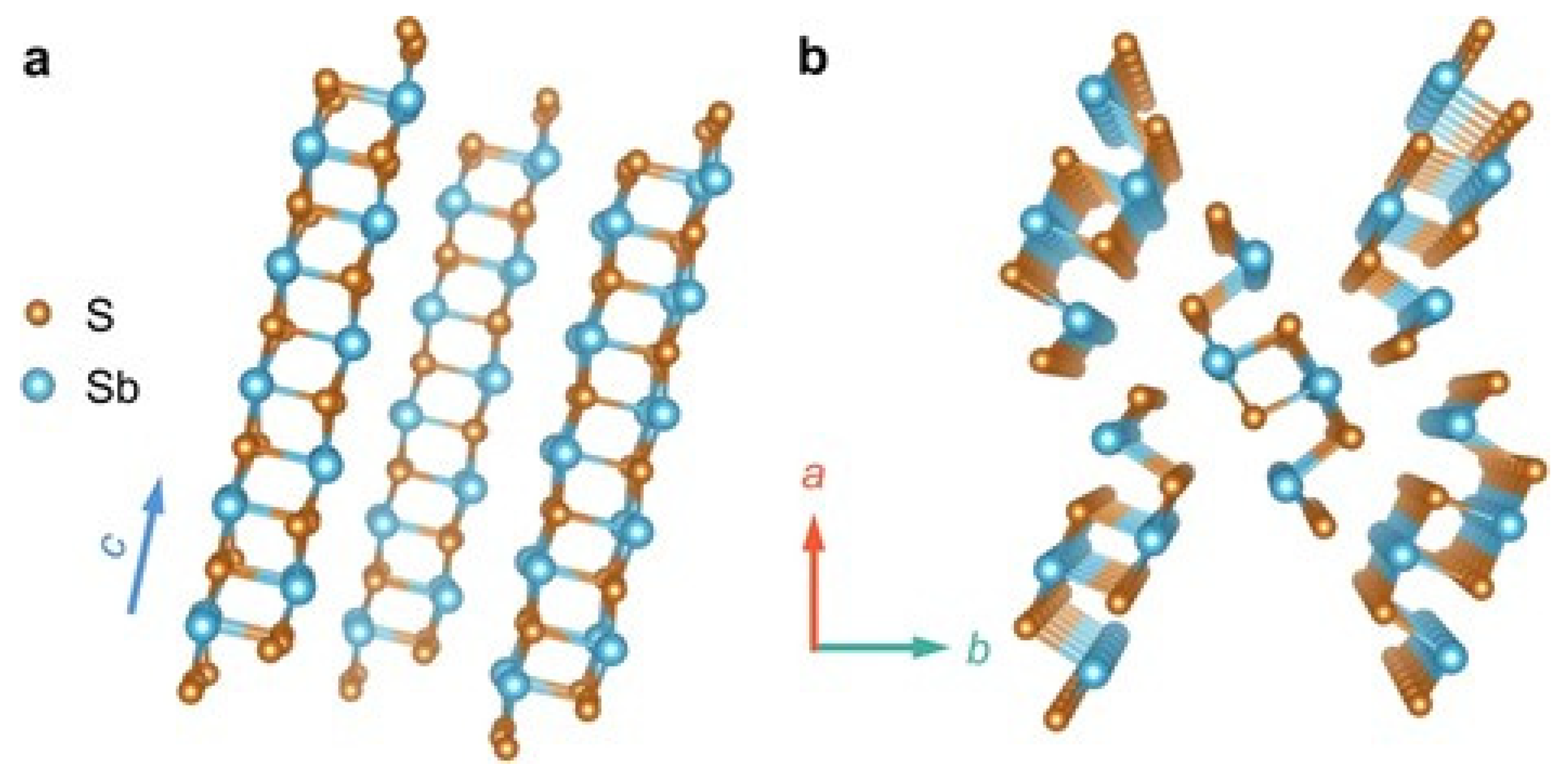
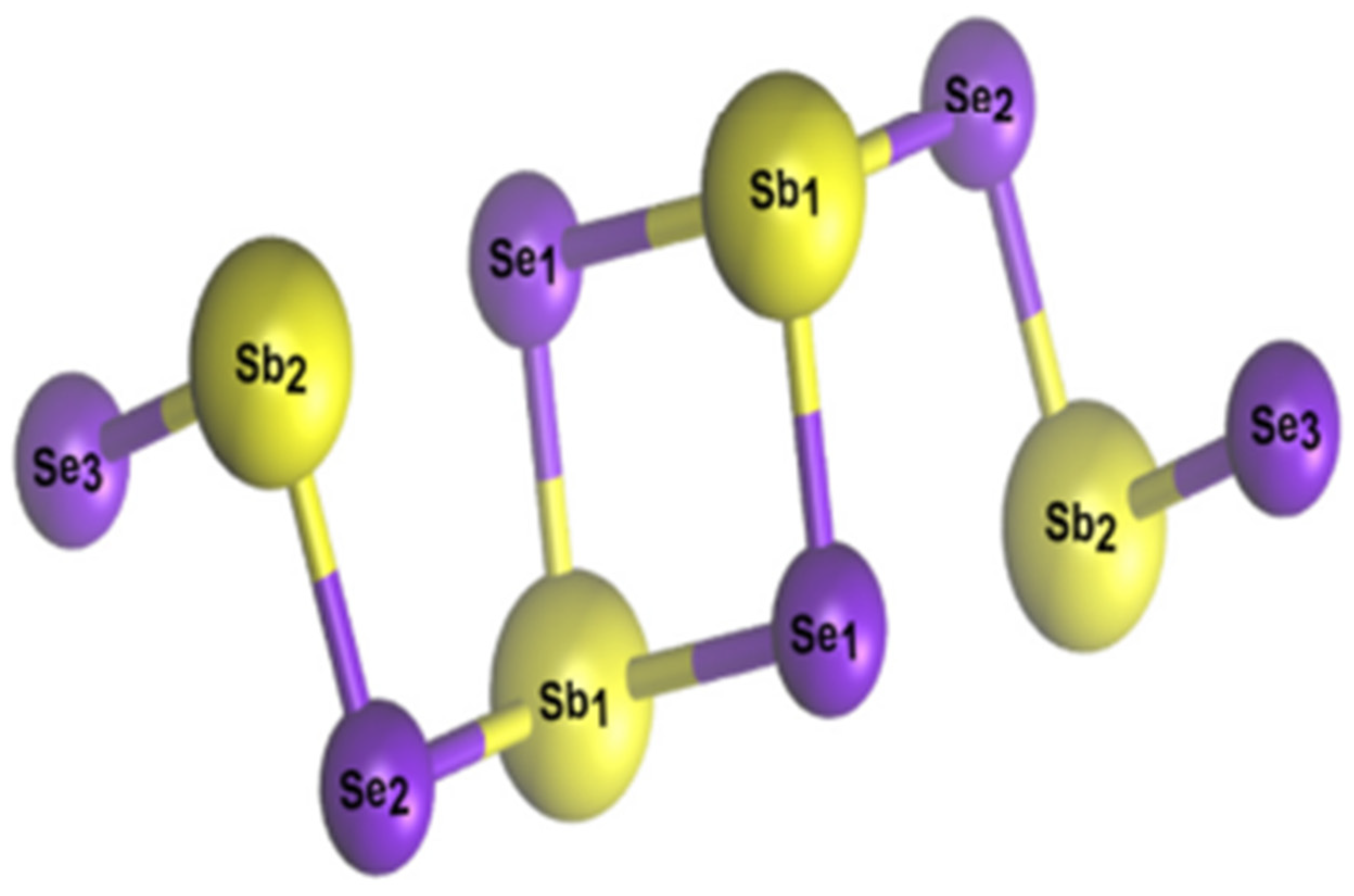
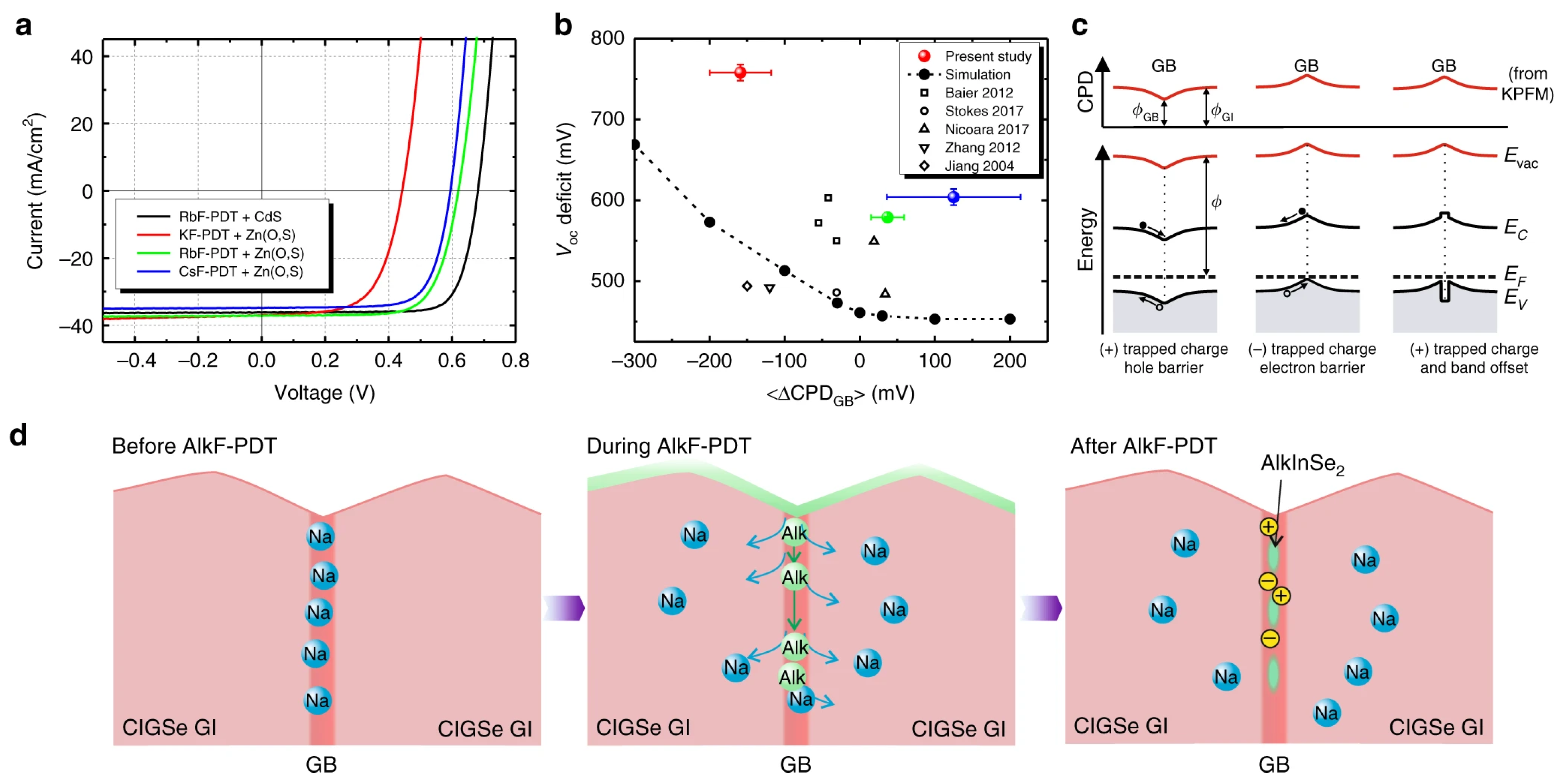

| Entry # | Material | Stage | Main Global Supplier | Share (%) | Entry | Material | Stage | Main Global Supplier | Share (%) |
|---|---|---|---|---|---|---|---|---|---|
| 1 | Antimony | E | China | 74 | 23 | Magnesium | P | China | 89 |
| 2 | Baryte | E | China | 38 | 24 | Graphite | E | China | 69 |
| 3 | Bauxite | E | Australia | 28 | 25 | Natural rubber | E | Thailand | 33 |
| 4 | Beryllium | E | USA | 88 | 26 | Neodymium | E | China | 86 |
| 5 | Bismuth | P | China | 80 | 27 | Niobium | P | Brazil | 92 |
| 6 | Borate | E | Turkey | 42 | 28 | Palladium | P | Russia | 40 |
| 7 | Cerium | E | China | 86 | 29 | Phosphate rock | E | China | 48 |
| 8 | Cobalt | E | Congo, DR | 59 | 30 | Phosphorous | P | China | 74 |
| 9 | Coking coal | E | China | 55 | 31 | Platinum | P | South Africa | 71 |
| 10 | Dysprosium | E | China | 86 | 32 | Praseodymium | E | China | 86 |
| 11 | Erbium | E | China | 86 | 33 | Rhodium | P | South Africa | 80 |
| 12 | Europium | E | China | 86 | 34 | Ruthenium | P | South Africa | 93 |
| 13 | Fluorspar | E | China | 65 | 35 | Samarium | E | China | 86 |
| 14 | Gadolinium | E | China | 86 | 36 | Scandium | P | China | 66 |
| 15 | Gallium | P | China | 80 | 37 | Silicon | P | China | 66 |
| 16 | Germanium | P | China | 80 | 38 | Tantalum | E | Congo, DR | 33 |
| 17 | Hafnium | P | France | 49 | 39 | Terbium | E | China | 86 |
| 18 | Ho, Tm, Lu, Yb | E | China | 86 | 40 | Titanium | P | China | 45 |
| 19 | Indium | P | China | 48 | 41 | Tungsten | P | China | 69 |
| 20 | Iridium | P | South Africa | 92 | 42 | Vanadium | E | China | 39 |
| 21 | Lanthanum | E | China | 86 | 43 | Yttrium | E | China | 86 |
| 22 | Lithium | P | Chile | 44 | 44 | Strontium | E | Spain | 31 |
| Solar Cell | LCA (MJ/m2) | EPBT (Year) | GHC (g CO2-eq/kW h) |
|---|---|---|---|
| mono-Si | 2860–5253 | 1.7–2.7 | 29–45 |
| Multi-Si | 2699–5150 | 1.5–2.6 | 23–44 |
| Thin film | |||
| a-Si | 710–1990 | 1.8–3.5 | 18–50 |
| CdTe | 790–1803 | 0.75–2.1 | 14–35 |
| CIS | 1069–1684 | 1.45–2.2 | 10.5–46 |
| Element | Symbol | Production as Hitchhiker % | Attractor Metal |
|---|---|---|---|
| Rare Earths | REE | 47 | Fe |
| Antimony | Sb | No data | Au, Cu, Pb |
| Molybdenum | Mo | 100 | Cu |
| Germanium | Ge | 100 | Zn |
| Gallium | Ga | 100 | Al |
| Indium | In | 100 | Zn |
| Platinum | Pt | 100 | Cu, Ni |
| Palladium | Pd | 100 | Cu, Ni |
| Rhodium | Rh | 100 | Pt/Pd |
| Ruthenium | Ru | 100 | Pt/Pd |
| Cobalt | Co | 85 | Ni 50% Ru 35% |
| Selenium | Se | 100 | Cu |
| Vanadium | V | 74 | Fe 59%, Al, U |
| Tellurium | Te | 100 | Cu |
| Entry | Material | Cell Efficiency (%) Year | Module Efficiency (%) Year | ||
|---|---|---|---|---|---|
| 2016 | 2021 | 2016 | 2021 | ||
| 1 | Mono-crystalline Si | 25.3 [37] | 26.7 [4] | 22.4 [37] | 24.4 [4] |
| 2 | Multi-crystalline Si | 21.9 [37] | 24.4 [4] | 18.5 [37] | 20.4 [4] |
| Thin film | |||||
| 3 | a-Si | 12.7 [37] (2015) | - | 12 [56] | - |
| 4 | CIGS | 22.6 [37] | 23.6 [37] | 17.5 [37] | 19.2 [4] |
| 5 | CdTe | 22.3 [37] | - | 18.6 [37] | 19.0 [4] |
| 6 | CZTS | 9.5 [37] | 13.0 [37] | n.a. | n.a. |
| 7 | SbSSe | 5.79 [57] | 10.1 [41] | n.a. | n.a. |
| Method | General Features |
|---|---|
| Vacuum techniques | Controlling the film composition and the corresponding phase profile. A considerable amount of energy is required to deposit material from the target sources, and the relatively slow throughput and low utilization of materials are not beneficial for large-scale production [83]. |
| Sputtering | [84,85] |
| Atomic Layer Deposition (ALD) | [86,87] |
| Thermal evaporation | [88,89] |
| Vapor Transport deposition (VTD) | [90,91] |
| High Vapor Transport Deposition (HVTD) | [61] |
| Vacuum electrodeposition | [92] |
| Non-vacuum techniques | Reduced capital equipment costs, lower temperature process, higher suitability for large-area and flexible substrates, higher throughput. |
| Spray pyrolysis | [93,94] |
| Chemical Bath Deposition (CBD) | [95,96,97] |
| Sol-gel | [98,99,100] |
| Hydrothermal methods | [101] |
| Spin coating | [102] |
| Dip coating | [102] |
| Spray coating | [102] |
| Electrodeposition | [103,104] |
| Entry | Absorber Material Thin-Layer | HTL, Counter Electrode | Electron Transport Material (ETM) | Fabrication Method | Power Conversion Efficiency (η, %) | VOC (V) | Remarks | Year | Ref. |
|---|---|---|---|---|---|---|---|---|---|
| 1 | Sb2 (S,Se)3 | Spiro-OMeTAD *, Au | FTO **/TiO2 | Solution (one-step spin-coating deposition) | 5.8 | 0.52 | -DMF, a weak basic solvent, enables simultaneous dissolution of Se and Sb2O3 with carbon disulfide (CS2) and n-butylamine (nBA) in the solution. -Pure crystal phase is obtained. -Abundant pin holes, responsible for low efficiency. | 2018 | [126] |
| 2 | Sb2 (S,Se)3 | C, Ag | FTO/CdS | Thermal evaporation | 5.74 | 0.48 | Composition of the films may be varied along its thickness in the thermal evaporation. Graphite electrode: the basic consideration here was the ease of preparing an electrode with a work function of near 5 eV for the p-side, which was not chemically reactive with antimony chalcogenide. | 2019 | [127] |
| 3 | Sb2(S,Se)3 | Spiro-OMeTAD, Au | FTO/TiO2 | Solution (one-step spin-coating deposition) | 4.49 | 0.53 | The solution is composed of 1.0 mmol of Sb2O3, 1.0 mmol of Se, and 0.1 mmol of CsOH· xH2O, mixed solvent of 2.0 mL of DMF and 1.5 mL of carbon disulfide, 2.0 mL of n-butylamine was added. | 2019 | [128] |
| 4 | Sb2(S,Se)3 | Spiro-OMeTAD, Au | FTO/TiO2/CdS | Solution (one-step spin-coating deposition) | 4.74 | 0.61 | The solution is the same as entry 3. The efficiency increase is due to the difference: FTO/TiO2/CdS instead of FTO/TiO2. | 2019 | [128] |
| 5 | Sb2 (S,Se)3 | Spiro-OMeTAD, Au | FTO/TiO2/In:CdS | Solution (one-step spin-coating deposition) | 6.29 | 0.59 | The solution is the same as entry 3. The efficiency increase is due to the difference: FTO/TiO2/In:CdS instead of FTO/TiO2. | 2019 | [128] |
| 6 | Sb2 (S,Se)3 | Spiro-OMeTAD, Au | FTO/TiO2/In:CdS | Solution (one-step spin-coating deposition) | 6.63 | 0.59 | The solution is the same as entry 3. The efficiency increase is due to the difference: FTO/TiO2/In:CdS instead of FTO/TiO2. | 2019 | [128] |
| 7 | Sb2(S,Se)3 | Spiro-OMeTAD/Au | FTO/CdS | Two-step synthesis: -In situ hydrothermal growth; -Post selenization. | 6.14 | 0.732 | This study unveils the great potential of the hydrothermal method in the fabrication of high-performance Sb2(S,Se)3 thin film solar cells. | 2019 | [129] |
| 8 | Sb2 (S,Se)3 | CsPbBr3 QDs, Au | FTO/CdS | Two-step synthesis: -In situ hydrothermal growth; -Post selenization. | 7.82 | 0.620 | This study shows another application of perovskite materials and a practical strategy towards the efficiency improvement of Sb2(S,Se)3 solar cells. | 2020 | [130] |
| 9 | Sb2 (S,Se)3 | Spiro-OMeTAD/Au | FTO/CdS | Two-step synthesis: -In situ hydrothermal growth; -Annealing under N2. | 10.1 | 0.630 | Antimony potassium tartrate (APT), sodium thiosulfate (STS), and selenurea (SU) were used as sources of antimony, sulfur, and selenium, respectively, in the hydrothermal system. Through the optimization of the hydrothermal deposition parameters and subsequent annealing, high quality Sb2(S,Se)3 films with an optimal morphology grain size and a reduced number of defects can be obtained. | 2020 | [115] |
| 10 | Sb2 (S,Se)3 | Spiro-OMeTAD/Au | FTO/CdS | Two-step synthesis: -In situ hydrothermal growth; -Annealing under N2. | 10.5 | 0.664 | Ethylen diaminetetraacetic acid (EDTA) was added to the hydrothermal mixture of APT, STS, and SU (the same used in [104], entry 9), resulting in an improvement in film quality and electrical properties. | 2020 | [131] |
| 11 | Sb2 (S,Se)3 | Spiro-OMeTAD/Au | FTO/Zn(O,S)/CdS | Three step synthesis: - In situ hydrothermal growth; -Solution post treatment (SPT) using alkali metal fluorides as additives (NaF, KF, RbF, and CsF); -Annealing. | 10.7 | 0.673 | An alkali fluoride post treatment is capable of vertically manipulating the Se/S distribution and forming additional favorable Se/S gradient distribution. | 2022 | [125] |
Disclaimer/Publisher’s Note: The statements, opinions and data contained in all publications are solely those of the individual author(s) and contributor(s) and not of MDPI and/or the editor(s). MDPI and/or the editor(s) disclaim responsibility for any injury to people or property resulting from any ideas, methods, instructions or products referred to in the content. |
© 2023 by the author. Licensee MDPI, Basel, Switzerland. This article is an open access article distributed under the terms and conditions of the Creative Commons Attribution (CC BY) license (https://creativecommons.org/licenses/by/4.0/).
Share and Cite
Buonomenna, M.G. Inorganic Thin-Film Solar Cells: Challenges at the Terawatt-Scale. Symmetry 2023, 15, 1718. https://doi.org/10.3390/sym15091718
Buonomenna MG. Inorganic Thin-Film Solar Cells: Challenges at the Terawatt-Scale. Symmetry. 2023; 15(9):1718. https://doi.org/10.3390/sym15091718
Chicago/Turabian StyleBuonomenna, Maria Giovanna. 2023. "Inorganic Thin-Film Solar Cells: Challenges at the Terawatt-Scale" Symmetry 15, no. 9: 1718. https://doi.org/10.3390/sym15091718






